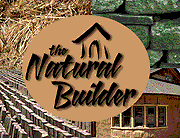Earth Sheltered Design
Sponsored in part by:

|
The Natural Builder
P.O. Box 855
Montrose, CO 81402
Phone/Fax: 970-249-8821
The Natural Builder offers on-site construction help, consulting and workshops related to natural plasters, earthen floors, monolithic adobe (cob), straw-bale and other green building projects. We also authored The Natural Builder book series on Earthen Construction, Monolithic Adobe, and Earth and Mineral Plasters. These books are available at our web site:
www.naturalbuilder.com.
|
DEFINITION:
Earth-sheltered design employs the earth as a major component of a building's thermal control system.
CONSIDERATIONS:
Using the earth as a component of the energy system, or "earth-tempering," can be accomplished through three primary methods: direct, indirect, and isolated. In the direct system, the building envelope is in contact with the earth, and conduction through the building elements (primarily walls and floor) regulates the interior temperature. In the indirect system, the building interior is conditioned by air brought through the earth, such as in earth tubes. The isolated system uses earth temperatures to increase the efficiency of a heat pump by moderating temperatures at the condensing coil. A geothermal heat pump is an example of an isolated system. This discussion will focus on direct and indirect systems.
High humidity levels in our area may create mood problems in direct and indirect earth sheltered systems. Good ventilation and dehumidification can reduce these problems in direct systems. High temperatures and low ground moisture in the summer (moist soil conditions are preferable for best conductivity) must also be addressed for optimal benefits from earth sheltering.
In the winter, passive solar features can maintain comfort levels by warming the thermal mass. (Earth-sheltered homes are typically built with concrete, which has high-thermal mass.)
Costs for a home incorporating direct earth-sheltering can run about 10% higher than conventional building. Some manufactured systems are closer to conventional home costs. Lower maintenance and operating costs are typical for earth-sheltered homes.
|
| Commercial
Status |
|
Implementation
Issues |
|
|  |
 |
 |
|
 |
 |
 |
| Earth Sheltered Design |
 |
 |
 |
|
 |
 |
 |
| Legend |
 |
Satisfactory
|
 |
Satisfactory in most conditions
|
 |
Satisfactory in Limited Conditions
|
 |
Unsatisfactory or Difficult
|
COMMERCIAL STATUS
TECHNOLOGY:
Moderately developed. It is generally acknowledged that additional research is needed as well as standardization of terminology and measurements used by researchers. However, earth-sheltered homes and buildings have been successfully constructed throughout the world.
SUPPLIERS:
Limited.
COST:
Costs for an earth sheltered home can run 10% higher than conventional homes. Costs are location-specific.
IMPLEMENTATION ISSUES
FINANCING:
May require additional work with lenders. Numerous precedents exist.
PUBLIC ACCEPTANCE:
There is limited interest in this type of building due to lack of exposure to examples in our area and misconceptions regarding the interior environment of this type of home. The non-traditional appearance hurts general appeal.
REGULATORY:
The layout of the rooms will have to accommodate a means of egress from sleeping areas.
GUIDELINES
1.0 Indirect Systems (Earth Tubes)
- 1.1 Description
- Cooler earth temperature is transferred to air brought into a house through a tube(s) buried in the ground.
- Outside air is brought through the tube(s) either by fans or natural convection.
- 1.2 Indoor Air Quality
- In a warm, humid region, it is possible for humidity to condense in the tube creating a good environment for mold growth.
- 1.3 Benefits/Capacity
- Calculating benefits from the use of earth tubes is difficult due to fluctuating soil temperatures and conductivity.
- Some analyses have shown that earth tubes can compete with a heat pump when earth temperatures of 58 F are available. However, groundwater temperatures at the 50-150 foot depth in central Texas are typically 72-75 F, indicating this strategy is most useful in augmenting other systems, such as earth-coupled (geothermal) heat pumps.
- 1.4 Earth Tube Guidelines:
- Small diameter tubes are more effective than large diameter tubes per unit surface area.
- Multiple small tubes optimize performance. Parallel 12 inch tubes typically offer the highest energy and cost efficiencies. (Two 300-foot 12" tubes in parallel or a single 500- foot 18" tube perform similarly.)
- Long tubes are not needed. The air temperature in the tube reaches the ground temperature quickly.
- Tubes should be placed as deep as possible.
- Using a closed loop by circulating the house air through the earth tube results in the best efficiency and reduces problems with humidity condensing inside the tubes.
- The tube material is not a factor in the system's cooling effectiveness. Plastic or metal materials will perform equally.
- Moist soil conditions enhance the system's performance.
- Circulating water through underground pipes eliminates the threat of contamination from molds. The water can be used to cool thermal mass in the house or as the cooling source for an air handler system.
- An earth tube system is typically not competitive with mechanical air conditioning on solely an economic basis.
- 2.1 Description
- Direct systems utilize conduction through building elements as the regulator of the indoor temperature. Generally speaking the largest climatic advantage of this system is in helping cool the living space.
- Buildings can be earth-covered in varying degrees. If the structure is built on the surface grade and earth is added around it, it is considered a bermed structure.
- Buildings can be constructed below grade or into hillsides and be totally or partially covered by earth.
- 2.2 Performance Characteristics
- It is generally considered that earth-sheltered structures in this region are of marginal benefit to the operating energy costs of a building. It must be recognized that practically all earth sheltered homes are designed with passive solar principles. From the standpoint of the quality of the energy source, earth-sheltering and solar energy can be considered superior to fossil fuels.
- Additional factors such as the desirability of noise reduction, reduced impervious cover, storm protection, and capability to blend with the natural environment (all characteristics of earth-sheltered homes) must also be considered in ascertaining the value of this type of construction.
- 2.3 Insulation
- In areas of cold winter temperatures, insulation is added to the full exterior of a building that is earth-sheltered.
- In this region, insulation (R-10 to R-20) is recommended only over the roof area and extending 8 feet out around the upper portion of the building. This prevents temperature variations in the upper walls.
- Extruded polystyrene is the most suitable insulation material for earth contact. This insulation has CFC's or HCFC's. New high density expanded polystyrene (uses no CFC's or HCFC's) may be suitable.
- If the building is bermed, the upper portion of the building should be insulated to the same standards used in above ground structures.
- 2.3 Earth-covering
- An earth-covered roof should be limited to no more than three feet of soil.
- Twelve to twenty-four inches (adequate for plant growth ) is typically used. This is too shallow to effectively insulate the building and is the reason that roof insulation is required.
- 2.4 Indoor Air Quality
- High humidity in our region will require that well-designed levels of ventilation and/or dehumidification be incorporated in these types of structures.
- The lack of air infiltration in an earth-sheltered structure intensifies the need to eliminate pollutants within the house. Mechanically-controlled air infiltration via energy recovery ventilators can mitigate such concerns and should be strongly considered, particularly those models with humidity regulation capabilities.
- 2.5 Lighting
- As in passive solar structures, an east/west axis should be emphasized in the earth-sheltered home. The glass area then lies predominantly on the south wall (see section on Passive Solar Design).
- Light wells are often added to bring light to the interior of the house and interior surfaces are designed to reflect light deep into the house. The light wells should be designed to admit indirect summer light by having a roof and open sides.
- 2.6 Waterproofing
- Waterproofing of an earth-sheltered building is of primary importance. Most earth-sheltered homes are made from concrete to provide the necessary strength to support heavy earth loads.
- Proper drainage techniques along the building perimeter and roof portions are required. The exterior surfaces then require durable, high quality waterproofing to eliminate leak potential. This is best accomplished by starting with a crack resistant concrete structure. Post-tensioned structures, due to the presence of constant compression, will best accommodate successful waterproofing.
- 2.6.1 Waterproofing Options:
- Built-up asphalt and pitch membranes. Long term stability and durability below grade is questionable.
- Cementitious materials. Can be used on a non-cracked surface successfully and can be applied on the interior if needed to stop a leak.
- Polyurethane-based liquid applied waterproofing systems. Application requirements and characteristics make these difficult to use successfully.
- Modified bituminous (rubberized asphalt). Very careful application needed to insure bonding of the sheets to the surface. Backfilling must be carefully done soon after application.
- Vulcanized and plastic sheets. Include butyl, EPDM, neoprene, Hypalon, CPE, PVC. Seams should be minimized with these materials. Hypalon absorbs water and is not suitable. PVC's longevity is questionable. Very careful professional installation is required. These materials are the most costly of the waterproofing options.
- Bentonite Clay Products. Available in various forms. Spray on, trowel on, and cardboard panels are common types used in underground buildings. Interior leak repairs can be done with bentonite. Backfilling must be done with care, and application skill ranges from low (trowel), to moderate (cardboard panels), to high (spray).
- 2.7 Overall Considerations
- The construction techniques required for earth-sheltered homes are quite exacting and should be extensively studied before building.
- Site-specific techniques that account for soil characteristics, topography, rainfall characteristics, ground water levels and pressure, loading, and slope stability should be used.
RESOURCES
PROFESSIONAL ASSISTANCE
Environment Associates
4219 Richmond Ave. Ste 250
Houston, TX 77027-6889
(713) 528-0000
architectural services
COMPONENTS / MATERIALS / SYSTEMS
R. C. Smoot Construction, Inc.
9107 Towana Trail
Austin, TX 78736-294
(512) 288-1001
GENERAL ASSISTANCE
return to
Table of Contents
This document was adapted to HTML by Bill
Christensen, sysop and environmental editor of Texas InfiNet, an online
community for progressive information.
Sustainable Building Sourcebook web version copyright Sustainable
Sources 1994-1999.


